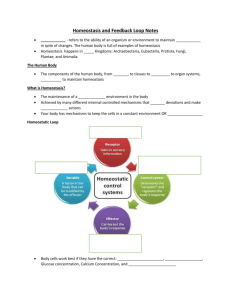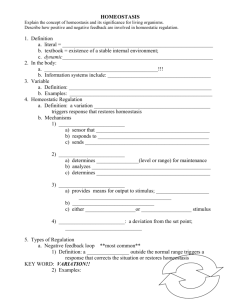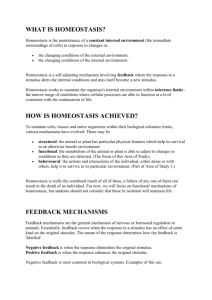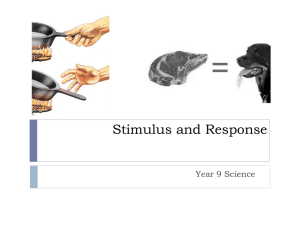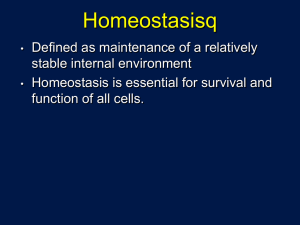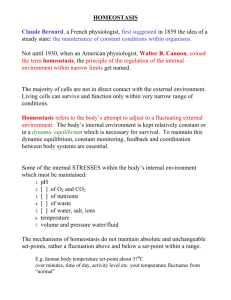Homeostasis and Feedback Mechanism
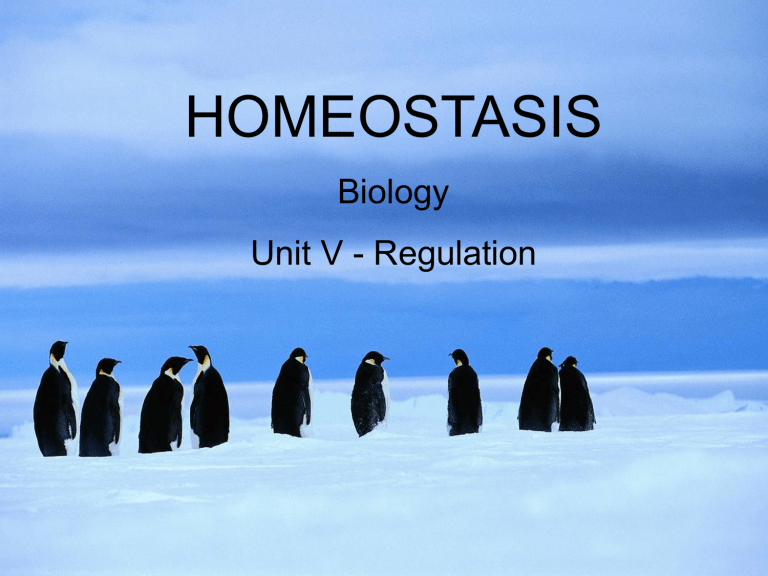
HOMEOSTASIS
Biology
Unit V - Regulation
WHAT IS HOMEOSTASIS?
• the maintenance of a constant internal environment in response to changes in:
– the changing conditions of the external environment.
– the changing conditions of the internal environment.
HOW IS HOMEOSTASIS
ACHIEVED?
To maintain cells, tissues and entire organisms within their biological tolerance limits, various mechanisms have evolved.
HOW IS HOMEOSTASIS
ACHIEVED?
structural : the animal or plant has particular physical features which help its survival in an otherwise hostile environment.
HOW IS HOMEOSTASIS
ACHIEVED?
functional : the metabolism of the animal or plant is able to adjust to changes in conditions as they are detected.
HOW IS HOMEOSTASIS
ACHIEVED?
behavioral : the actions and interactions of the individual, either alone or with others, help it to survive in its particular environment.
Maintaining Homeostasis through
Behavior Changes?
Examples of Homeostasis in Animals
FEEDBACK MECHANISMS
Feedback mechanisms are the general mechanism of nervous or hormonal regulation in animals.
• Negative feedback is when the response diminishes the original stimulus.
• Positive feedback is when the response enhances the original stimulus.
FEEDBACK LOOPS
• Feedback mechanisms have certain essential components.
• Stimulus : The change from ideal or resting conditions .
• Receptor : The cells or tissue which detects the change due to the stimulus.
• Relay : The transmission of the message , via nerves or hormones or both, to the effector.
FEEDBACK LOOPS
• Effector : The cells or tissue , usually a gland or muscles, which cause the response to happen.
• Response : An action, at cell, tissue or whole organism level which would not have occurred in the absence of the stimulus.
• Feedback : The consequence of the response on the stimulus . May be positive or negative.
Negative Feedback
Positive Feedback
Negative feedback is most common in biological systems.
Negative Feedback
Examples of Negative Feedback
• Blood glucose concentrations rise after a sugary meal (the stimulus),
• the hormone insulin is released and it speeds up the transport of glucose out of the blood and into selected tissues (the response),
• so blood glucose concentrations decrease
(thus decreasing the original stimulus).
Examples of Negative Feedback
• Exercise creates metabolic heat which raises the body temperature (the stimulus),
• cooling mechanisms such as vasodilatation (flushed skin) and sweating begin (the response),
• body temperature falls (thus decreasing the original stimulus).
Positive feedback is less common , which is understandable, as most changes to steady state pose a threat, and to enhance them would be most unhelpful.
Examples of Positive Feedback
• A baby begins to suckle her mother's nipple and a few drops of milk are released
(the stimulus).
• This encourages the baby and releases a hormone in the mother which further stimulates the release of milk
(the response).
• The hungry baby continues to suckle, stimulating more milk release until she stops.
Examples of Positive Feedback
• A ripening apple releases the volatile plant hormone ethylene (the stimulus).
• Ethylene accelerates the ripening of unripe fruit in its vicinity so nearby fruit also ripens, releasing more ethylene (the response).
• All the fruit quickly becomes ripe together.

